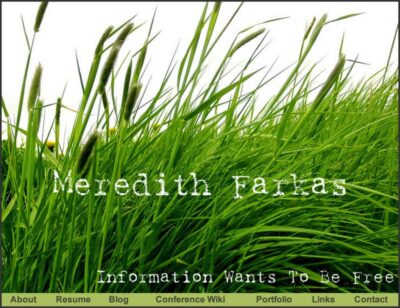Meredith asked me to write about 5 things i think work pretty well. And i
do as i’m told. So here they are.
1) Konica/Minolta DiMAGE Scan Dual IV
This is a so-called ‘film scanner’ or ‘slide scanner’. It lets you scan 35mm
film negatives or slide positives into the computer. The resulting output
is eye-popping (especially considering the scary shape the slides were in).

The three things that make the DiMAGE cool are –
* low price. it’s like $250, which is an order of magnitude lower than
comparable scanners just a couple of years ago.
* batch scanning. Using the right software (vuescan from hamrick is my
favorite), you can do automated batch scanning — stick 4 slides in, wait,
when they pop out, stick another 4 in, etc… no need to babysit the
computer. That’s important when you’ve got 3,000 slides to scan.
* DigitalICE. It’s got hardware correction built in, which takes out the
slide’s imperfections. It can also restore faded colors.
2) OS X. The mac’s operating system is the most useful desktop OS
currently available. The most important trait is that it just
“disappears” when you’re using the computer. That is, you’re not
constantly worrying about it, unlike Windows. No need for virus
scanners, “zone alarm”, worrying about spyware, patches-of-the-minute,
etc. It is thoughtfully architected at its lowest levels, and the user
experience is unparalleled. It’s what linux on the desktop should be, but
isn’t (yet). Ye Olde Mac G3’s are also great, cheap file & print servers.
They are more than fast enough, robust, easy to configure, and use very
little electricity when the screen is off.
If you’re looking to just “experiment” with a Mac, you can pick a good fruity-colored G3 iMac up off eBay for a couple of hundred bucks. It’s also rumored that Apple is going to release a sub-$500 mac within the next couple of months.
3) KDE’s kio_slaves. One thing that the linux desktop does get right is
the kio_slave system in KDE, and the “fish” slave in particular.
KDE is one of the top two graphical ‘desktop environments’ for linux. KDE’s Fish makes
files anywhere on the network appear like they are on your local hard
drive. Lets say you’re working on your web site, creating files on your
local machine. Normally, you’d need to upload them, using something like
secure FTP or scp. This extra step is a pain in the tail. With fish,
when you open up an “open file” dialog box, you don’t just get to look at
files on your own hard drive — you can see files on other -servers-,
anywhere that you have a login. So, when the file dialog opens for me, i
can open the file “afarkas@myserver.com/myfile.html”. Fish will load that
file as if it came from my hard drive. So when i hit the save icon while
i’m working, it automatically uploads it to the server.
This is known as “network transparency”, and KDE does it better than any
other environment. My guess is that OSX will have something similar soon,
since apple loves to cherrypick the best of the KDE program (the mac’s Safari
browser is just KDE’s konqueror with several enhancements.)
4) Skype. Meredith mentioned this one before, but it really -is- useful.
Yeah, it’s properietary VOIP, but it “just works” unlike so many other
VOIP apps. Turn it on and start talking.
5) OpenOffice.org. OpenOffice is a legit MS Office replacement, provided
you’re not doing anything really scary with Excel, or need a replacement
for Access.
It can read & write MS Office files, and does a pretty good job of maintaining the proper formatting. Occasionally you’ll see formatting glitches when opening MS Word files, but unless you are collaboratively writing the Great American Novel with someone using Word, it works more than well enough.
The word processing piece of OpenOffice also incorporates the notion of “styles”, so you can define different text styles very much like a CSS stylesheet. It makes making mass changes to a document incredibly easy. We use OOo to write our documentation at our firm, and it really makes formatting tasks much simpler than Word.
I’ve been playing with the 2.0 pre-release of OOo, and it looks like the developers decided to come out with their own Access clone
that can interface with real databases (postgresql, etc) too. The 2.0 release
isn’t expected for many months, but 1.1.4 which is available for download
at the OpenOffice.org site, works just fine. It can even output files to
PDF, which is something that I don’t think even MS Office can do for free.
So, those are 5 things that I like. 🙂




Just FYI, that picture above is 33 years old, taken from a 35mm slide of the same age. The camera that took it was apparently a consumer-grade pentax.
The pic is a 120k jpg compressed down for the web from the 20MB tiff original.
Interesting list–but as for styles, they’re certainly part of every Word version I’ve used in the past five or six years, including the whole mass-changes concept. Heck, for that matter, you can just attach a new template to an existing document and change every style aspect of that template. If OpenOffice also has that, great–but it’s certainly part of Word. (For Windows, at least.)
The problems i have with word (after using it since the original word for dos, yikes) are numerous. The biggest probably is the closed file format. One critical advantage of OpenOffice (particularly for archival purposes) is that its file format is totally open and unobfuscated. The specification is well-known, and 50 years from now when we’re all dead and gone, people will still be able to read an OpenOffice file. That’s not necessarily the case for office. In fact, meredith was trying to read some of the stuff she wrote in high school in winword 2, and it didn’t render properly.
What has amazed me is how fast Open Office products are maturing. I’m running FC6 and 2.0.3 and rarely see any problems. The biggest problem is the FC6 printer driver not printing 2-up when printed from Impress and even that is being addressed as a bug. I haven’t played with Fish but do use Skype. Seems like the Open Source movement simply blew right past the rest of the guys over the last year.
Best, Tim, Serviza: http//www.serviza.com. Let’s Make Open Source Rock out of the Box.